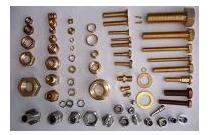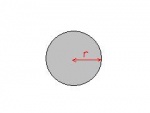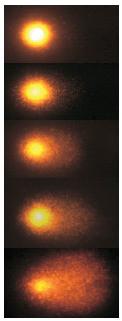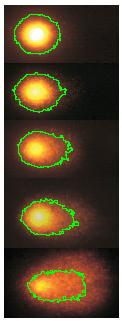This page is a part of CVprimer.com, a wiki devoted to computer vision. It focuses on low level computer vision, digital image analysis, and applications. It is designed as an online textbook but the exposition is informal. It geared towards software developers, especially beginners, and CS students. The wiki contains mathematics, algorithms, code examples, source code, compiled software, and some discussion. If you have any questions or suggestions, please contact me directly.
Roundness
From Computer Vision Primer
Suppose we want to count nuts and bolts in this image separately. Suppose we have detected and captured these objects. We can find their areas. However, since some of these objects have about the same size in terms of the area, we have to look at their shapes. We want to be able to evaluate shapes of objects and the most elementary way to do it is to compare the are and the Perimeter.
We compute the roundness of the object.
Roundness = 4π*area/perimeter2
The roundness will tell circles from squares and squares from elongated rectangles, as follows.
Roundness of circle = 1 Roundness of square = .785 Roundness of 1:5 rectangle = .436
The results are independent of resolution. This allows us to evaluate shape separately from size.
In binary images, objects appear as collection of pixels. The result is that objects are never entirely round.
The image is an example of computation of roundness with Pixcavator 2.4. For convenience we multiply roundness by 100.
For the image on the right we have the following data:
- 1. Large circle: Area = 9047, Roundness = 78
- 2. Large square: Area = 4891, Roundness = 79
- 3. Large square: Area = 4802, Roundness = 79
- 4. Large square: Area = 4761, Roundness = 79
- 5. Smaller square: Area = 2295, Roundness = 79
- 6. Small circle: Area = 1622, Roundness = 78
- 7. Rectangle: Area = 1050, Roundness = 43
- 8. Small square: Area = 840, Roundness = 81
- 9. Ellipse: Area = 647, Roundness = 39
In this image Pixcavator successfully distinguished between circles/squares and elongated objects.
For larger squares the roundness remains the same, while that of larger circles is higher. For example, a circle of radius 200 has roundness 89.
As before elongated objects are easily detectable. For example, the roundness of a 200×200 rectangle is 79 while that of 200×270 is 77.
Testing the program with objects of different sizes (up to 650x650) has confirmed the following conclusions:
- Large squares have roundness 79-80.
- Large circles have roundness 89-90.
- Elongated, rough edged, and non-convex objects have low roundness.
- Objects with just a few pixels have high roundness.
In the next, practical example we want to analyze and count these cells, first image. With size limit at 17, all cells are captured but also a lot of noise, second image. We can remove the noise manually, but it's not a good option if we have hundreds of images. A better option is to use the fact that cells are somewhat round. We set the roundness limit at 55 and the result is the last image. (Using the contrast will produce a similar result.)
Roundness is also known as circularity, while compactness is its reciprocal.
See also Lengths of curves.
Exercise. As the relative error of the computation of the perimeter may reach 8% (such as in Pixcavator and ImageJ), what about roundness?
Exercise. How can you use roundness to detect semicircles?
Download the free Pixcavator Student Edition here.
Digital discoveries
- Casinos Not On Gamstop
- Non Gamstop Casinos
- Casino Not On Gamstop
- Casino Not On Gamstop
- Non Gamstop Casinos UK
- Casino Sites Not On Gamstop
- Siti Non Aams
- Casino Online Non Aams
- Non Gamstop Casinos UK
- UK Casino Not On Gamstop
- Non Gamstop Casino UK
- UK Casinos Not On Gamstop
- UK Casino Not On Gamstop
- Non Gamstop Casino UK
- Non Gamstop Casinos
- Non Gamstop Casino Sites UK
- Best Non Gamstop Casinos
- Casino Sites Not On Gamstop
- Casino En Ligne Fiable
- UK Online Casinos Not On Gamstop
- Online Betting Sites UK
- Meilleur Site Casino En Ligne
- Migliori Casino Non Aams
- Best Non Gamstop Casino
- Crypto Casinos
- Casino En Ligne Belgique Liste
- Meilleur Site Casino En Ligne Belgique
- Bookmaker Non Aams
- онлайн казино с хорошей отдачей
- スマホ カジノ 稼ぐ
- Trang Web Cá độ Bóng đá Của Việt Nam






